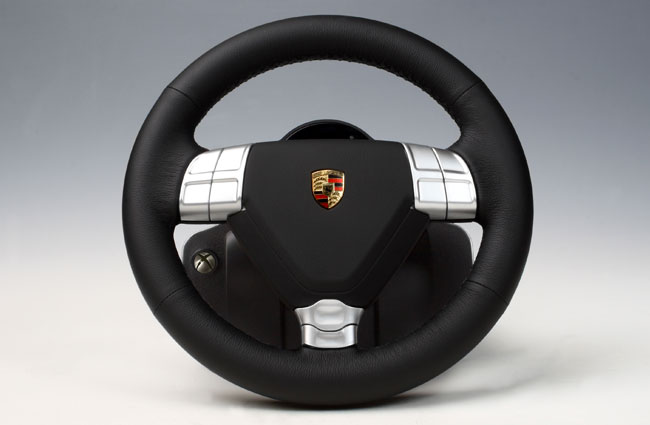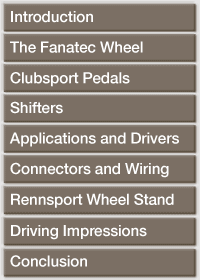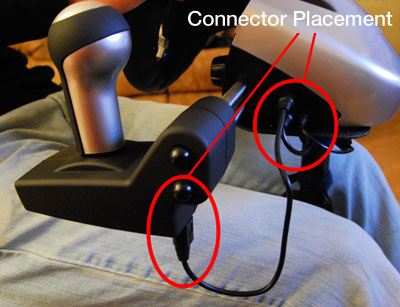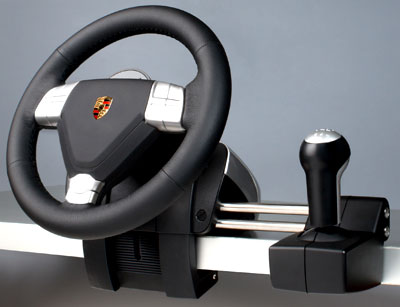|
Review: The Fanatec Porsche 911 Turbo S Wheel and Clubsport Pedals
Back To
Page 1
The Wheel
The Fanatec Porsche 911 Turbo S Wheel (known internally at Fanatec as the Porsche Wheel Turbo S, or PWTS for short), exudes a look and feel of quality right out of the box. It looks, feels, performs (and has a price tag) like it’s the zenith of sim racing controllers. The force feedback housing unit is finished in a high-grade silver metallic paint job that is simply perfect — it’s a pleasure just running your hand over the butter-smooth, automotive-grade finish. Integrated into the three wheel spokes are 8 programmable buttons, which include console-specific back-lit function indicator letters or symbols when used with the Xbox 360 or PS3. On the wheel’s bottom spoke, there’s an 8-way D-pad switch and a two-way rocker switch that acts as the back/start buttons in Xbox 360 mode, select/start in PS3 mode, and places the wheel into PC operation mode. The wheel’s housing unit also sports an Xbox Guide button.

 Inside the PWTS housing are three motors: two for producing various vibration feedback effects, such as engine rumble, pavement bumps and brake lockup. The third motor is a large Mabuchi RS 500, typically found in RC model applications, that drives the wheel via a Gates automotive-grade belt made in-part with carbon fiber. Fanatec says it went for a large, single FFB motor in order to reduce unwanted friction and resistance in the system. The drawback was higher heat levels from the single motor design, which they mitigated with some internal cooling fans and heat sinks that vent out of grates in the top of the wheel housing. The decision to go with belt drive was driven by a desire to reduce noise levels and that grinding vibration common to all gear-drive systems as the gear teeth mate and de-mate. The downside to this tri-platform compatible, single-motor/belt drive FFB design is a substantially higher cost than gear-driven systems like the Logitech G25 and Logitech G27 Driving Wheels. In fact, the Fanatec wheel with Clubsport Pedals and a shifter costs 180% more than its nearest rival, the Logitech G27. As my wife was so keen to point out, that’s a lot of dough for a "toy".
Inside the PWTS housing are three motors: two for producing various vibration feedback effects, such as engine rumble, pavement bumps and brake lockup. The third motor is a large Mabuchi RS 500, typically found in RC model applications, that drives the wheel via a Gates automotive-grade belt made in-part with carbon fiber. Fanatec says it went for a large, single FFB motor in order to reduce unwanted friction and resistance in the system. The drawback was higher heat levels from the single motor design, which they mitigated with some internal cooling fans and heat sinks that vent out of grates in the top of the wheel housing. The decision to go with belt drive was driven by a desire to reduce noise levels and that grinding vibration common to all gear-drive systems as the gear teeth mate and de-mate. The downside to this tri-platform compatible, single-motor/belt drive FFB design is a substantially higher cost than gear-driven systems like the Logitech G25 and Logitech G27 Driving Wheels. In fact, the Fanatec wheel with Clubsport Pedals and a shifter costs 180% more than its nearest rival, the Logitech G27. As my wife was so keen to point out, that’s a lot of dough for a "toy".
Back to the outside of the wheel. The stitched leather wheel rim is both wide (11½") and fat, and has just the right amount of resiliency. The paddle shifters have tiny metal wings attached to them, but are really just short-throw micro-switches that while precise have very little tactile response, making it difficult to tell if you’ve successfully actuated a shift — aside from seeing the gear change in-game. The buttons on the wheel are blended into the form of the wheel spokes — an innovative and discreet way to implement the Xbox 360 control button layout.  Other reviewers have raved about the wheel’s looks, but I’m not so sure. Although functional and attractive, the buttons’ action feels a little sloppy, and all the buttons have considerable play prior to engaging their contacts. The buttons are also not in the best ergonomic location for their use, and since they all feel the same, you have to look at them to use them correctly. But taken as a whole, the wheel is clearly a product that exudes the look and feel of quality. Other reviewers have raved about the wheel’s looks, but I’m not so sure. Although functional and attractive, the buttons’ action feels a little sloppy, and all the buttons have considerable play prior to engaging their contacts. The buttons are also not in the best ergonomic location for their use, and since they all feel the same, you have to look at them to use them correctly. But taken as a whole, the wheel is clearly a product that exudes the look and feel of quality.
The one thing that most displeases about the wheel housing’s design is the location of cable connectors for the pedals, USB and power supply. Attaching straight out of the left and right flanks of the force feedback housing, the wires and their connectors seem highly vulnerable to impacts and side-swipes that could damage them in the blink of an eye. The Shifter unit’s “chop sticks” provide some blocking, but only if you’re using that accessory. It would seem to have been better to place the wire connectors at the forward end of the housing, or recess them underneath the unit, as Logitech has done with its Logitech G25 and Logitech G27 wheels.
The wheel can be attached to a firm base in three ways: a "C-clamp" bracket with adjustable feet, a steel Clubsport Table Clamp available separately from Fanatec, and via four mounting bolt holes in the bottom of the wheel housing. As a high-end or "boutique" racing controller, the PWTS was clearly designed for use with a wheel stand or sim cockpit in mind. The wheel’s integral C-clamp is not terribly effective due to lack of clamping force and a small "contact patch", causing the wheel to shift its position on the desk during normal use. SimHQ’s review wheel is attached to the Rennsport Wheel Stand,  which proved rock-steady and reasonably portable — just the thing for multi-platform gaming. The mounting holes can be used for sim cockpit installs as well, as the PWTS comes with a drilling template, but Fanatec advises extreme care with bolt selection so that they don’t protrude into the wheel housing, where they could interfere with the belt drive or contact and damage the internal mechanisms. which proved rock-steady and reasonably portable — just the thing for multi-platform gaming. The mounting holes can be used for sim cockpit installs as well, as the PWTS comes with a drilling template, but Fanatec advises extreme care with bolt selection so that they don’t protrude into the wheel housing, where they could interfere with the belt drive or contact and damage the internal mechanisms.
Since the PWTS is a multi-platform wheel that works with two versions of gaming console, the wheel comes with an on-board tuning selector with a variety of variable settings independent of the gaming platform’s drivers or software. Pressing a small button on the wheel activates a small LED screen at the top of the wheel hub. Using the D-pad switch on the bottom spoke of the wheel allows programming of five memory slots (S_1 through S_5) for fine-tuning of the wheel. Tuning options include Sensitivity (SEn), which sets the wheel’s total rotation angle. In-wheel options include OFF, 210˚, 270˚, 540˚ (and 900˚ for the Xbox), with “OFF” being reserved for PC games to set their own rotation limits. Force Feedback strength (FF) is next, which can be selected at 0%, 33%, 66% and 100%. The force feedback in this wheel is so strong, most will find 33% or 66% to be sufficient. Next up is Shock/Vibration feedback (Sho), again selectable as 0/33/66/100 as per the FF options. Vibration feedback on the Fanatec wheel provides some environmental cues but also can be used to sense brake lockup, a very handy feature. Next up is the "Drift" mode (dri), selectable at OFF, 001, 002 or 003. Drift mode uses the internal motors to assist your inputs, making the car feel more responsive to wheel inputs.  Brake pedal vibration point (AbS) is the final option, which can be set at any level from OFF to 100%. AbS determines the amount of brake pedal force before the in-pedal vibration feedback motor starts to run. It’s a great way to adjust your brake pedal to alert you to impending brake lockup, although the intensity of vibration is a bit weak. Once you’ve made all your setting adjustments for a given memory “S” slot, you simply turn off the display to save the settings. I have reserved S_1 for my PC / rFactor, while S_2 is for my Xbox 360 / Forza Motorsport 3. It’s great to see adjustment provided on the wheel, and I can say that certain modes such as "dri" can make a real difference in how the wheel responds to inputs from the driver and feedback from the game. Brake pedal vibration point (AbS) is the final option, which can be set at any level from OFF to 100%. AbS determines the amount of brake pedal force before the in-pedal vibration feedback motor starts to run. It’s a great way to adjust your brake pedal to alert you to impending brake lockup, although the intensity of vibration is a bit weak. Once you’ve made all your setting adjustments for a given memory “S” slot, you simply turn off the display to save the settings. I have reserved S_1 for my PC / rFactor, while S_2 is for my Xbox 360 / Forza Motorsport 3. It’s great to see adjustment provided on the wheel, and I can say that certain modes such as "dri" can make a real difference in how the wheel responds to inputs from the driver and feedback from the game.
After the first time using the PWTS on the PC, returning to the Xbox 360 resulted in a mis-calibrated wheel, about 15 degrees off-center. Fanatec has provided a fix for this: Turn the wheel on, put it in PC mode (hold the "Back" button for ~2 sec), center the wheel correctly, then simultaneously push the two lower left side buttons while pushing the Xbox Guide button and releasing all three at once. This resets the firmware calibration point. Worked like a charm, and there’s been no calibration problems since.
Video: Fanatec discusses the Porsche 911 Turbo S Wheel
Go
To Page 3
Click here
to go to top of this page.
|


 Inside the PWTS housing are three motors: two for producing various vibration feedback effects, such as engine rumble, pavement bumps and brake lockup. The third motor is a large Mabuchi RS 500, typically found in RC model applications, that drives the wheel via a Gates automotive-grade belt made in-part with carbon fiber. Fanatec says it went for a large, single FFB motor in order to reduce unwanted friction and resistance in the system. The drawback was higher heat levels from the single motor design, which they mitigated with some internal cooling fans and heat sinks that vent out of grates in the top of the wheel housing. The decision to go with belt drive was driven by a desire to reduce noise levels and that grinding vibration common to all gear-drive systems as the gear teeth mate and de-mate. The downside to this tri-platform compatible, single-motor/belt drive FFB design is a substantially higher cost than gear-driven systems like the
Inside the PWTS housing are three motors: two for producing various vibration feedback effects, such as engine rumble, pavement bumps and brake lockup. The third motor is a large Mabuchi RS 500, typically found in RC model applications, that drives the wheel via a Gates automotive-grade belt made in-part with carbon fiber. Fanatec says it went for a large, single FFB motor in order to reduce unwanted friction and resistance in the system. The drawback was higher heat levels from the single motor design, which they mitigated with some internal cooling fans and heat sinks that vent out of grates in the top of the wheel housing. The decision to go with belt drive was driven by a desire to reduce noise levels and that grinding vibration common to all gear-drive systems as the gear teeth mate and de-mate. The downside to this tri-platform compatible, single-motor/belt drive FFB design is a substantially higher cost than gear-driven systems like the  Other reviewers have raved about the wheel’s looks, but I’m not so sure. Although functional and attractive, the buttons’ action feels a little sloppy, and all the buttons have considerable play prior to engaging their contacts. The buttons are also not in the best ergonomic location for their use, and since they all feel the same, you have to look at them to use them correctly. But taken as a whole, the wheel is clearly a product that exudes the look and feel of quality.
Other reviewers have raved about the wheel’s looks, but I’m not so sure. Although functional and attractive, the buttons’ action feels a little sloppy, and all the buttons have considerable play prior to engaging their contacts. The buttons are also not in the best ergonomic location for their use, and since they all feel the same, you have to look at them to use them correctly. But taken as a whole, the wheel is clearly a product that exudes the look and feel of quality. which proved rock-steady and reasonably portable — just the thing for multi-platform gaming. The mounting holes can be used for sim cockpit installs as well, as the PWTS comes with a drilling template, but Fanatec advises extreme care with bolt selection so that they don’t protrude into the wheel housing, where they could interfere with the belt drive or contact and damage the internal mechanisms.
which proved rock-steady and reasonably portable — just the thing for multi-platform gaming. The mounting holes can be used for sim cockpit installs as well, as the PWTS comes with a drilling template, but Fanatec advises extreme care with bolt selection so that they don’t protrude into the wheel housing, where they could interfere with the belt drive or contact and damage the internal mechanisms. Brake pedal vibration point (AbS) is the final option, which can be set at any level from OFF to 100%. AbS determines the amount of brake pedal force before the in-pedal vibration feedback motor starts to run. It’s a great way to adjust your brake pedal to alert you to impending brake lockup, although the intensity of vibration is a bit weak. Once you’ve made all your setting adjustments for a given memory “S” slot, you simply turn off the display to save the settings. I have reserved S_1 for my PC / rFactor, while S_2 is for my Xbox 360 / Forza Motorsport 3. It’s great to see adjustment provided on the wheel, and I can say that certain modes such as "dri" can make a real difference in how the wheel responds to inputs from the driver and feedback from the game.
Brake pedal vibration point (AbS) is the final option, which can be set at any level from OFF to 100%. AbS determines the amount of brake pedal force before the in-pedal vibration feedback motor starts to run. It’s a great way to adjust your brake pedal to alert you to impending brake lockup, although the intensity of vibration is a bit weak. Once you’ve made all your setting adjustments for a given memory “S” slot, you simply turn off the display to save the settings. I have reserved S_1 for my PC / rFactor, while S_2 is for my Xbox 360 / Forza Motorsport 3. It’s great to see adjustment provided on the wheel, and I can say that certain modes such as "dri" can make a real difference in how the wheel responds to inputs from the driver and feedback from the game.